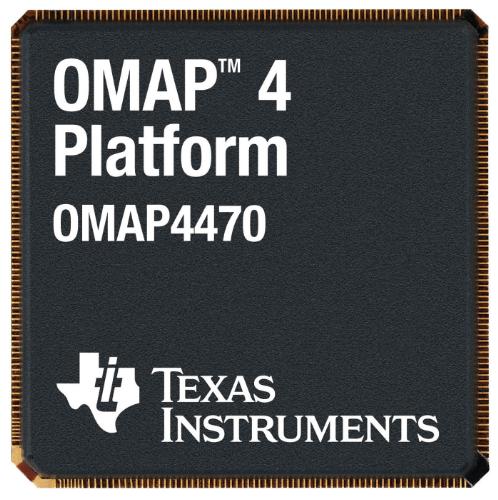TI's 1.8Ghz Multi-Core Chip with 3D Support
Texas Instruments revealed a new multi-core SoC featuring two ARM Cortex-A9 cores and a PowerVR SGX544 core among other components.
Thursday during Computex, Texas Instruments announced a new power-efficient, multi-core SoC called the OMAP4470 which offers up to 1.8 GHz clock speeds and support for three simultaneous displays.
Built using the 45-nm manufacturing process, the chip features two ARM Cortex-A9 MPCores, two ARM Cortex-M3 cores, a dedicated PowerVR SGX544 graphics core (from Imagination Technologies) and "a unique hardware composition engine" with a dedicated 2D graphics core. There's also a display subsystem supporting up to three HD displays simultaneously, "dual-channel" 466 MHz LPDDR2 memory and complete pin-to-pin hardware and software compatibility ranging from the OMAP4430 to the OMAP4460.
According to TI, the SGX544 portion will offer a 2.5x performance boost in the graphics department over the previous OMAP4430. It will also support DirectX, OpenGL ES 2.0, OpenVG 1.1 and OpenCL 1.1. The display subsystem in turn will provide resolutions up to 2048 x 1536 (QXGA) on three displays simultaneously, and even offer stereoscopic 3D via an HDMI connection. The 2D graphics core – along with the LPDDR2 memory – enables up to 7.5 GB/s of throughput to composite the graphics and/or video data output, thus freeing up the SGX544 GPU so that it can handle "intensive tasks" while maximizing power efficiency.
"Graphics processing is now at the very heart of the mobile computing experience, providing the gateway to an enriched experience of user interface, gaming, location services, web and media," said Hossein Yassaie, CEO, Imagination Technologies. "Combining the OMAP 4 platform's low-power, high-performance architecture with the extensive acceleration capabilities and API support of Imagination's POWERVR SGX544 will enable experiences that will really make people sit up and take notice."
TI also quietly revealed that "the next version of Microsoft Windows will benefit from the OMAP4470 processor's enhanced capabilities," namely hinting to Microsoft's use of the chip for Windows 8. The 45-nm OMAP4470 SoC – which will also play friendly with Linux and Android platforms – is expected to sample in the second half of 2011, with devices expected to hit the market in first half 2012.
Get Tom's Hardware's best news and in-depth reviews, straight to your inbox.

Kevin Parrish has over a decade of experience as a writer, editor, and product tester. His work focused on computer hardware, networking equipment, smartphones, tablets, gaming consoles, and other internet-connected devices. His work has appeared in Tom's Hardware, Tom's Guide, Maximum PC, Digital Trends, Android Authority, How-To Geek, Lifewire, and others.
-
helldog3105 Yes the specifications would indicate that it is fast, the question is how fast is in relation to the new platform coming from nVidia, and what is the power consumption like between the two platforms?Reply -
mosu I think this chip is more power efficient than Nvidia solution, but let's wait for benchmarks.I still think it's a better solution overall.Reply -
danwat1234 FINALLY! Will TI finally make calculators that have processors that run faster than 12MHZ?Reply -
Max Collodi vaughn2kSo when would be the benchmarks?Probably as soon as there are devices available to put them in.Reply
